 |
Golden Gringo Chronicles |
|---|
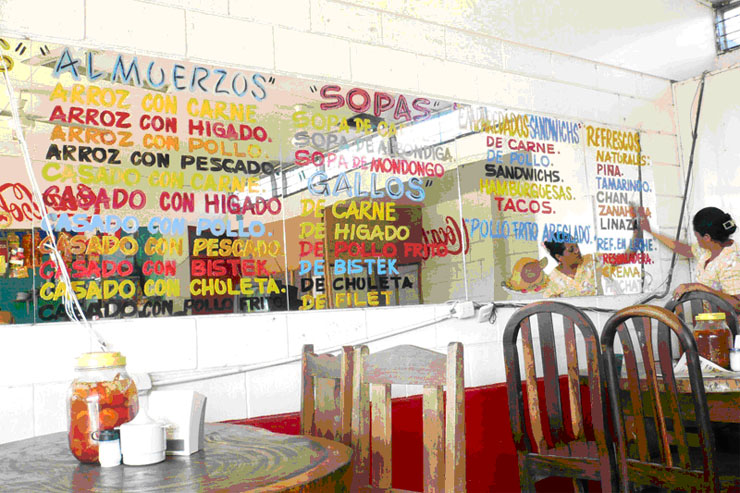 |
|---|
| Lunch is Served. Dude, Sopa de Higado (Liver Soup) for Lunch -Now That's Different! |
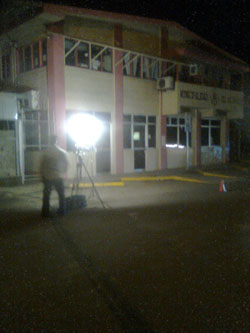 |
|---|
TV Coverage of the Town Hall was on Site Late Into the Following Night |
In the early hours of the morning on Wednesday, December 21, the OIJ (Costa Rica's FBI) and other police forces descended on the Municipal Offices of Quepos (Town Hall) and arrested the mayor and his driver. The mayor's name is Lutgardo Bolaños.
The two men were charged with human trafficking and employing girls, some of them underage, to make porno films. The girls came from poor areas of Costa Rica ranging from San José to Golfito.
Investigators found 600 compact disks and pornography on the mayor's computer. The mayor was also charged with corruption as public funds were used to produce and distribute the films as well as pay for "tours" around the country during which new candidates were recruited.
GG passes by the Municipal Office almost every day on the way to central Quepos and the bus station. Early on the morning of the 21st there were dozens of police, police vehicles, news vans and cameras surrounding the offices. This is not the kind of area publicity citizens and residents hope for.
This is the second Acalde of Quepos in as many mayors to be escorted from office by the national police. Bolanos' predecessor, Oscar Monge, was pushed out of office in October of 2010 by the OIJ for corruption related to his selling of municipal camera equipment for personal gain. At least with Monge it was standard politician fare, stealing. This latest sordid mayoral adventure is much more hurtful, particularly to the victims, and one would hope the courts would slap a long prison term, like life, on these perpetrators.
I couldn't help but wonder at how different things would have turned out if my landlady had one the last Municipal Elections.
Bridge Business
A little over two years ago I hitched a ride from Quepos to San José with a Tico friend. The Autopista had not yet opened, but Instead of taking the more common mountain road through Atenas, he suggested we take an even more scenic route through Puriscal to reach the central valley.
So at Orotina we went right instead of left and took a different pass through the mountains. The view was indeed magnificent. We had a great lunch at a restaurant nestled into the side of the mountain road that is known for it's large, pan-fried tortillas with cheese. Yummers.
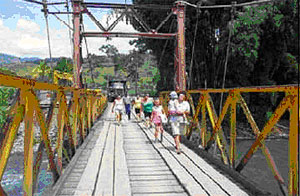 |
|---|
A Bridge Like the One at Turrabares that Collapsed in October 2009 - Note the Truck Waiting to Come Across After the People |
Along the road we reached a bridge that consisted of a one lane, cable-suspended wooden plank span similar to the one in the picture to the left. The bridge we took is located near the town of Turrabares and crosses the Rio Tárcoles, the same river that exits to the Pacific near Jacó. Like the one in the picture, it also was used for one-lane vehicular traffic as well as for pedestrians. We rattled slowly across the bridge at Turrabares while a truck on the other side waited for us to clear and get its turn.
A few weeks after we had crossed the Turrabares bridge it made history by collapsing into the Tárcoles carrying a bus with it and killing six people. The death toll would have been much higher except that it was in the dry season and the river was relatively low and less turbulent. The normal procedure for a bus to cross the old bridge was for the passengers to get off, walk across the bridge and then be followed by the empty bus. For some reason that day the driver decided to cross fully loaded.
Bridges are always a concern in a country mostly built on a mountain range that forms a spine that runs down the middle of the country and creates numerous rivers. The government recently announced that a new bridge will be constructed at Turrabares to replace the collapsed one. This time it will be a much stronger, all metal bailey bridge. The government has favored the bailey bridge in recent years because of it's high strength to weight ratio, easy installation and low cost.
When GG first started coming to Costa Rica eight years ago there were 11 one-lane bridges on the main route between Quepos and San José, now there is only one (in Quepos) if you use the Autopista route and three if you take the old mountain road through Atenas. Significant progress, amigo.
For more on the interesting history of Bailey Bridges, go here: Bailey Bridge.
OK, this falls into the I-Think-I've-Seen-It-All category.
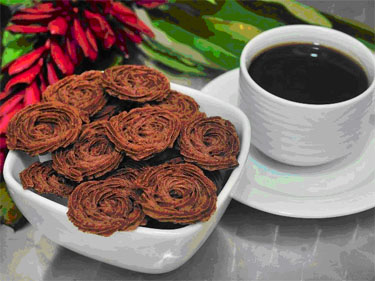 |
|---|
Gallo Pinto Cookies - Gotta Get a Sample |
For those of you who are familiar with or perhaps even a fan of Gallo Pinto like our hero, you know that this curious, grayish blend of black beans and white rice with a touch of aromatic vegetables and spices is truly a unique taste of Costa Rica, perhaps even it's signature dish.
But amigos, it's for enhancing breakfast or perhaps lunch, n'est ce pas? Well some creative Ticos do not feel bound by tradition and have come up with an unexpected variation for this Tico specialty, gallo pinto cookies. Whodathunkit?
Press reports indicate the product was invented in a northern border town near the frontier with Nicaragua. This, of course, makes our hero suspicious that the real intention here is a subtle attempt by Nicaragua's President Danny Ortega and his Nica bullies to undermine Tico culture. More will be revealed but I think it would be a good idea for the World Court to stay alert in case the international struggle between the Ticos and the Nicas over the northern border escalates over this delicacy also.
La Nación, our largest newspaper, reported that plans at this time call only for test marketing the "Galletas de Gallo Pinto" in regions of the north where the product was invented. The recipe is a closely guarded secret (we don't want a Pillsbury copy, do we?). Who knows what will happen after test marketing. First the supermarkets, then Walmart - the world can be our oyster, ...er, rooster. Stay tuned, GGC will keep its best investigative reporters on this story ... (sorry, GG gets carried away sometimes).
I wonder if gallo pinto cookies or gallo pinto buns would go well with liver soup (header picture above)? For more on Gallo Pinto or "Spotted Rooster" go here: SPOTTED ROOSTER.
New Year's in Costa Rica, like in most places around the world, is a time for personal review, self-renewal and philosophizing about the future. There are some traditions practiced here that are definitely latino and there are some that are peculiarly Costa Rican. For example:
 |
|---|
Here We Have Santa Working On the Red Underwear Tradition (So That's Why He's So Jolly) |
I suggested to one of my Tico buddies that logic might demand wearing red scivies and a yellow t-shirt and that might bring both the mate and good luck or good luck with the mate, or whatever.
I'm told the Ticos have a saying on the practice of wearing red underwear (they seem to have a saying for everything): “el que de rojo se viste, en la calle lo desvisten” which means if you wear red, they will tear your clothes off in the street. But what it really means, or at least implies, is that you will have a lot of sex in the coming year (OK., I've found my mantra for 2012 and I'm throwing out all my tighty whities in favor of reds).
And then there are the "pólveros" or fireworks. Sure, everybody does fireworks around the New Year but it seems to me that the Ticos love of them is second to none.
The pólvero stands and kiosks start blossoming all over town around the middle of November. Just about every corner grocery store adds a large glass case near their main entrance to grab the attention of customers; and business at these stands is brisk throughout the holiday period.
 |
|---|
Fireworks - How the Ticos Love 'em |
I'm told that selling fireworks in Costa Rica is legal but setting them off is not. Yeah right, like the fuzz is really watching. My guess is the cops are also setting them off, probably from their cruisers. Private fireworks displays are routinely set off every night beginning in mid-November right up to the big night, then the displays intensify.
On New Year's Eve, from my balcony I can see the considerable fireworks show put on by the city at the waterfront and innumerable smaller displays all over the city and up on Manuel Antonio hill as well. Last year my landlord's son and I set off our share of small roman candles from a vacant lot nearby. Kids will be kids. I'm leaning towards buying bigger ones this year; it's a competitive thing, amigos.
So. if you happen to be in Quepos in Barrio Los Angeles around midnight on December 31 and see a man in red and yellow underwear running in circles around his apartment building carrying a backpack, while eating grapes, in the midst of a fireworks bombardment, be not afraid, 'tis only our hero trying to get into the season.
Later, on New Year's day you'll find me at the beach fighting for a chair and umbrella with the best of them.
Prospero Año, Felicidades y Pura Vida Amigos!
Speaking of New Year's traditions, how about the sweet treats.
One time, in the early days of residency here, our hero was walking through Super Mas and noticed a small section in the produce department that offered dark brown, round mounds (say that five times fast after a few beers) about six inches in diameter and four or five inches high. "Que es esto?" asked I, using one of the few Spanish phrases I had at the time, "What is this?".
"Oh, senor", says one of my clerk buddies, "it's 'tapas de dulce'." Kool dude, but what the hell is tapas de dulce amigo? I came to learn that tapas de dulce is nothing more than concentrated unadulterated sugar from cane. Later I would see someone at the weekend farmer's market (La Feria) processing cane stalks by running them through a machine that looks like a wood chipper but which instead smashes and squeezes the stalks to extract the sugar liquor which is collected at the bottom of the machine.
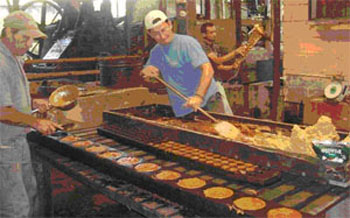 |
|
|---|---|
(↑↓) Tapas de Dulce Being Formed in Trapiches |
|
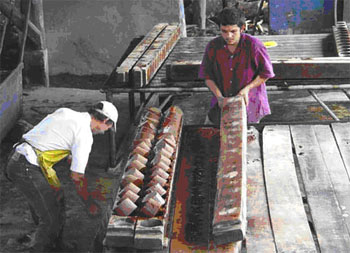 |
|
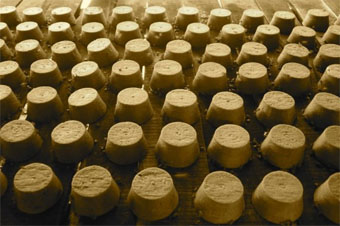 |
|
Final Product - Tapas de Dulce |
|
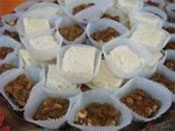 |
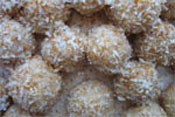 |
Above - Two Types of "Cajetas" Made With Tapas de Dulce:
Left - Fudge and Right - Coconut Balls |
|
So how do you make those little round bricks out of sugar juice? You do it in a molding unit called a "trapiche" (photos of tapas de dulce being produced in trapiches are shown left).
Like many historical traditions, trapiches are rapidly disappearing. In the Canton of Alejuela alone, a suburb of San José, there used to be over 60 units, now there are none. Those that are remaining are to be found in the more rural areas of the country.
The process for making tapas de dulce using a trapiche is as follows:
2. The sugar cane juice is heated up in a number of huge metal pans to concentrate it. A special tree bark is added which makes the impurities rise to the surface where they can be skimmed off. (Budweiser has uses a similar process with wood chips to remove excess yeast which they call "beachwood aging"). After concentration, the juice moves to another vessel to boil vigorously for five minutes.
3. Next comes a long wooden container similar to a dugout canoe where the juice is stirred until it thickens and becomes light brown (methinks this is simply partial caramelization which gives it the color).
4. The final stage is to put the hot, thick sugary substance into molds, where it cools and hardens and can then be unmolded.to yield the product shown at left - pure sugar.
Tapas de Dulce ingots are typically produced in small, family-owned manufacturing plants which are virtually open to the atmosphere except for a roof. There are always swarms of bees buzzing around, especially at the molding stage, yet nobody seems to get stung. I guess the bees are riding a super high and don't care.
Unfortunately, the Trapiches, as mentioned above are rapidly disappearing giving way, like in most places, to more modern processes. Let's hope these little plants won't disappear completely.
OK, so now that we've got finished tapas de dulce, what do you do with it? Make lots of different sweets, of course.
Some devoteés simply form or mold the raw tapa into little pieces and shapes, perhaps add some flavoring and eat it neat (these are called Melcochas and zowee, they are sweet). Or you can make a fudge of tapa dulce, condensed milk, coconut and orange peel called Cajeta de Coco. Another derivative is the making of a thick syrup of tapas and milk called Dulce de Leche which, if properly concentrated can be used as an icing or frosting..
When using Tapas de Dulce, you're limited only by your confectionary imagination.
Schweeeeeet.
You may recall that our hero received a serious setback in obtaining his Costa Rican residency card (cédula) last August (see GULLIBLE TRAVELS). I immediately set about obtaining all new documents, particularly the critical two, the birth certificate and police background check. Both of these are required to be certified by respective secretaries of states in the states where one was born and where one last lived. Then they need to be "authenticated" (read processed for a fee) by the Costa Rican Consulate in Washington, D.C.
While waiting for the two docs to process through the several stages from the U.S., additional trips were made to San José to obtain other required miscellaneous items such as new fingerprints from the Police Academy., more passport-like photos and a new income verification letter from Social Security obtained at the U. S. Embassy. The original, certified and authenticated Massachusetts birth certificate and Florida police report arrived in my mail box on November 3, one day before my planned trip to Panama. I put the docs on hold while I completed the trip and 90-day visa renewal requirement.
After returning from the grueling PANAMA bus trip (16 hours travel time in four days with no sleep for two nights) I turned around the next morning and took the 6 AM bus to San José to present my new documents to Inmigraciόn. My Spanish teacher Jorge came with me, just in case my Spanglish failed, which, of course, it would have, as the proceedings were entirely too detailed for my level of Español.
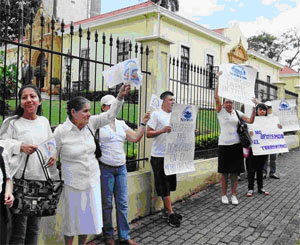 |
|---|
Casa Amarilla - Not Sure Why These People are Demonstrating - Perhaps It's the Anti-Rubber Stamp Occupy Group |
On the three hour bus trip, Jorge and I reviewed a list of items required by Immigration and I noticed a vague pen note on the margin of my checklist that said “Casa Amarilla” or Yellow House. We called Casa Amarilla from the bus and learned we did indeed need to get another “authentication” at the Yellow House in addition to the authentication we got from the Washington Consulate before we could submit the documents to Immigration. Casa Amarilla houses the Costa Rican Ministry of Foreign Affairs. From the bus depot in SJ we headed directly to Casa Amarilla.
The yellow house is located on a green hill near a red light district on the opposite side of the city from Immigration. On the sidewalk in front of the Casa, we were confronted by a lady selling what looked like postage stamps in small plastic packets of two each. GG was hesitant to buy them at first because I thought it might be a scam but Jorge said buy it, it’s only 1,000 colones and we might need them. We purchased one packet of two stamps for 1,000 colones ($2).
Inside we picked a number and waited for about 20 minutes for our turn. The lady then said that one cannot buy the authorization stamps inside the Casa; that’s done outside on the street and that we needed a total of four stamps, not two. Jorge rushed out to buy two more stamps while the clerk began affixing the two we had given her to my documents. Jorge returned quickly and after affixing all four stamps, rubber stamping them thrice with different stamps, the clerk took them into a room behind the service desk where, evidently, there is a special bureaucrat who gives the final official signature of approval. We resumed our seats in the waiting area and in about ten minutes my name was called. We quickly exited the Yellow House with the re-re-authorized docs in hand. We grabbed the first available taxi.
Upon arriving at Immigration we remembered there was one additional document, an application form, that we were told on our last visit could be gotten at the last moment. The receptionist at the main immigration hall told us we could get the form at the Information window which we had passed on the way in. Now, Immigration does one thing right that some of the other government agencies don’t; they have preferential lines at most windows and service desks for old (65+) geezers like GG.
When we got to the information window there were many people in line (my guess was an hour long wait) but I noticed there was a window for “preferenciales” like me. We assumed position number five in this line behind a man with a cane and three women with babies (I'm not too proud to seek advantage in a line). After about fifteen minutes we got to be number one and were told that the form isn’t at the information window, it’s at the “copias” window. So we shifted over to that window and assumed an un-preferential position in a long line as we could see no pref line offered. But Jorge wormed his way up to the window and told the man we just wanted the form, not copies. He got it.
| Press Report: |
|---|
"In 1949 (founding year of the new republic) the Costa Rican State employed only 6% of the working population; today the government pays the salaries of 25%, or one in four employed people" |
| (I think I've met most of them-GG ) |
We then returned to the main hall where, as usual, there were some 100 plus people, mostly of Latino extraction with a sprinkling of gringos and Europeans, milling about and waiting in the various sections on color-coded chairs (I have no idea what each color means). The receptionist gave us a ticket for the preferential section and we gained access to a clerk within about 30 minutes. This gentleman was a pleasant looking dude in his fifties and Jorge told him I was there to make application for a cédula.
The clerk found my name in his computadora and stated that I had already made application. Jorge told him the whole story about the first application being rejected due to insufficient evidence (i.e., incomplete documents resulting from my then intermediary’s incompetence), the advice of another clerk that I start from scratch, etc. (full story here: GULLIBLE TRAVELS). The clerk reviewed my packet containing the certified and re-re-authenticated birth certificate and police report, the fingerprints receipt form from the Police Academy, the Social Security income verification letter, the application form, the bank receipt for $30 deposited to a government account at Banco de Costa Rica, extra photos and copies of all pages in my passport.
 |
|---|
"We Realize It's An Unnecessary Department, But the Acronym Was Just too Cool
to Shut It Down" |
Of course this wasn't enough stuff to meet the requirements. Our new friend said we also needed:
1. “official” translations of the birth certificate and police report,
2. a personal letter in Spanish asking for pensionado or retired residency status (the same info that was on the application form obtained at the copias window but done, in this form, as a personal letter) and, oh yeah,
3. the deposit now must be $250; not $30 as stated on the previous version of the form we used as a checklist.
We left Immigration just before noon hoping to get all these tasks done.
Why, to our surprise (a little tongue in cheek here), there is an office just outside the Immigration main gate that does “official” translations (i.e., affixing with the appropriate postage/rubber stamps by a notary). At five minutes before noon, we dropped the documents off after pre-paying the 20,000 colone fee per document – total $80. Come back in an hour they said, at 1 o’clock, and they’ll be ready.
Now there is a BCR (Banco de Costa Rica) deposit office on the south side of the Immigration campus and we proceeded there but, unfortunately it doesn’t also have an ATM to extract the money that needs to be deposited there. That BCR ATM is about a half mile away on the opposite side of the immigration campus across from the translation office, so we proceeded back to the main entrance. I tried to get $230 more out of that machine, but as the Peter Principle was fully operating that day, the machine kept telling me that it could only offer dollars, not colones (fancy that). Yo, machine dude, that ‘s all I’ve been asking for. It’s not like I didn’t know the navigation pattern for a BCR ATM as I use one all the time in Quepos. But there would be no luck with this obstinate machine.
I finally gave up and suggested to Jorge we find another BCR branch. After walking a half mile and then trying a couple of locations by taxi that didn’t have both an ATM and a deposit desk, we lighted on one that did. After extracting and depositing the additional $230, we went looking for an internet café where Jorge could write the request letter. Eventually we found one and completed that 10 minute creative process. I then spied a Chinese restaurant in the same shopping complex, so we went there for lunch, giving the translation office at little more time. We had an excellent (real) Chinese meal. Casually we took a taxi back to the Immigration area to pick up the translations, arriving at 2 PM.
Of course, the docs weren’t ready. We waited another 15 minutes for them to find my docs they had done nothing with in our absence and convert them, via a computer template, to two additional, one-page, 2 sided, ivory-colored, legal size documents they could then affix their own special postage stamps, emboss with their seal, rubber stamp in two places and sign with the usual flourish. Now, that’s ”official”, eh what?
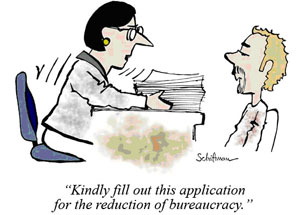 |
|---|
On returning to the Immigration hall at about 2:30, I noticed no one in line as we passed the copias and informaciόn windows and suggested to Jorge that Immigration might be closed. When we entered the main hall there were absolutely no applicants and only two or three clerks milling around behind the platform desks. We learned that the Immigration office is only open from 8 AM to noon but Jorge engaged a female clerk who said we needed to talk to Cynthia, who must be one of the big quesos there.
While Jorge was talking with the clerk, I spotted the dude who we had talked to earlier in the day and asked Jorge to engage him. Jorge became the silver-tongued Tico Diablo dude I’ve come to respect, pleading with the man that we had come all the way from Quepos and could he help us? To verify we were from Quepos, I produced my Florida driver’s license with the Quepos address on it (don't ask), the only picture identification I had with my address (my CR license shows no address - again, don't ask).
To my surprise, the clerk sat down and began to process my application, sorting through the documents, entering each into the computer, affixing more stamps we had purchased earlier at the copias window and stamping with at least three different rubber stamps. After about 15 minutes he placed the packet on a pile of file folders and gave me the routine Comprobante Requisitos status report that we had used earlier as a checklist with one important difference; this was the first time in two years that I had received one of these "en tramite" reports with all the pertinent boxes checked off as completed. The clerk casually said to check back in 90 days (mid-February). The gods be praised; the Force had been with us. I thanked the clerk in my best Spanish as we departed (I thought kissing him would be a little too much for both of us).
We headed back into central San José to get the next bus to Quepos. Riding back home at the end of this day, which had followed on the heels of the extremely tiring Panamá trip, I felt a little like the proverbial Freenie bird. For those of you who are not familiar with this specie, the Freenie bird is a broad-winged feathered creature that resides in remote and difficult environs and has a penchant for flying in ever-decreasing concentric circles until it succeeds in shoving it’s head up it’s butt.
But above all, I felt elated and satisfied at finally reaching this important stage.
Pascua
I just got used to referring to easter as Pascua when a Tico friend said to me a few days ago (December): "Feliz Pascua de Navidad".
Now wait a minute amigo, aren't you confusing Christmas time with Easter says I. Oh no amigo, says he, "We used to say feliz pascua de navidad long before we said feliz navidad but the latter is the more commonly used form today." Sure enough, when I checked my Océano dictionary for pascua I got: (1) Easter and (2) Christmas.
The word is rooted in the term "Pasch" which is the term used both for the Jewish Passover and the Christian Easter. When used in a country like Costa Rica, referring to pascua at Christmas is a way of bringing to mind the "Paschal Lamb" characteristic of Jesus, the story of suffering and sacrifice behind the birthday remembrance. After reading this I couldn't help but wonder if the disassociation of pascua from Christmas in the U.S. was one of the reasons why the emphasis there has long ago shifted from the religious meaning to the strong commercial nature of the holiday we see today..
There was a third meaning or use of pascua in my Océano: if one says "de Pascuas a Ramos" it means "once in a blue moon". Really, whatever. I wonder who Ramos was? "It's not a person dummy, says my Spanish teacher Jorge, it's a day - Palm Sunday". Since Easter to Palm Sunday is 51 weeks, nearly the whole year, it's once in a blue moon.
Vivir y entender (live and learn).
La Hacienda (Note: This restaurant has changed hands since this review and is now known as Restaurant Salt)
Location: About one mile up from the Quepos football field on the Manuel Antonio main road on
the left (east) side of the road in the Centro Comercial Plaza Yara.
Hours: Monday to Friday 10AM to 10PM; Saturday and Sunday 4-10PM
Parking: Ample - Directly in Front of the Restaurant
Contact: Tel: (506) 2777-3473; Email: lahaciendacr@yahoo.com
Reviewing ROMEOS: Brian M., Alice Lee, Bob N.
This is an old restaurant on Manuel Antonio hill with new owners, a family where Mom and Dad were busy on the floor and behind the bar servicing customers while we were there. Son and chef Cody was busy walking around the restaurant checking with customers when he was not in the kitchen supervising food preparation. Attention and service to the customer was a hallmark of our experience here The wait service was also prompt, pleasant and attentive.
The dining room is plain but pleasant with tables unadorned by flowers, decorations or candles. One plus for this anciano with a bad back was that the chairs had some padding to them, a difficult thing to find sometimes in this area The lighting is of a pleasant level although one of us (guess who) had trouble reading the menu but I attribute this more to the use of a thin script font on the pages and some fading of the print from use. |
 |
||
|---|---|---|---|
$$$$$ |
There was a duo of singing guitar players that started playing in the middle of our dinner. For us old folks this was an unnecessary addition and made having conversation a little difficult but, from the applause the duo received, it was apparent that the younger people in the room didn't see it that way.
The ROMEOS chose different appetizers, one a salad, another humus with pita and a third had a mango based salsa with chips. All were fresh and tasty.
For main courses two of us chose the "Chicken La Hacienda", a sauteed breast stuffed with vegetables and shrimp and covered in a light white sauce. The Dorado Dude went for a tenderloin filet that had been coated in ground coffee and finished with a demi glace. The filet was cooked to a perfect medium rare as requested and was very tender and flavorful. The plates were well presented and the main courses accompanied by sauteed or roasted potatoes with a touch of thyme and a steamed vegetable melange of carrots and broccoli, done just tender.
For deserts, we had a lime pie, a brownie with ice cream. and a mocha cheesecake accented with chocolate, whipped cream and a few crunchy coffee beans (the Dorado Dude was on a coffee kick that night and a cup of good Costa Rican coffee completed the binge). Cross sampling of the deserts produced a set of "oh yeah"'s.
The food was excellent, the service was excellent and, except for the minor points mentioned above, the atmosphere was very pleasant, The group had no problem giving a four sloths rating for food, ambiance and service.
The three course meals mentioned above came in at 18,000 to 22,000 colones ($36 to $44) without alcoholic beverages. This puts the restaurant at a five dollar price level, our highest, but it's typical of the better restaurants in Manuel Antonio and quite reasonable for the quality level.
(Note: La hacienda is also the site of the annual fall Chile Cook Off where chefs and locals compete for top prize and are selected for it by the attending public. It's a great way to spend an afternoon nibbling on a dozen or more variations of this Tex-Mex favorite while kibbitzing with the neighbors.)
James Madison on thriftiness in federal spending:
"I cannot undertake to lay my finger on that article of the Constitution which granted a right to Congress of expending, on objects of benevolence, the money of their constituents...." --James Madison
and Tom Jefferson on the same:
"I wish it were possible to obtain a single amendment to our Constitution ... taking from the federal government their power of borrowing." --Thomas Jefferson (Letter of November 26th, 1798)
don Roberto de Quepos, El Gringo Dorado Pura Vida! |
To Contact GGC World Wide Headquarters (yuk, yuk) to request deletion from the Chronicles distribution, make comments, suggest topics or criticize my bad jokes, send an email to: bob@bobnormand.com. |
|---|